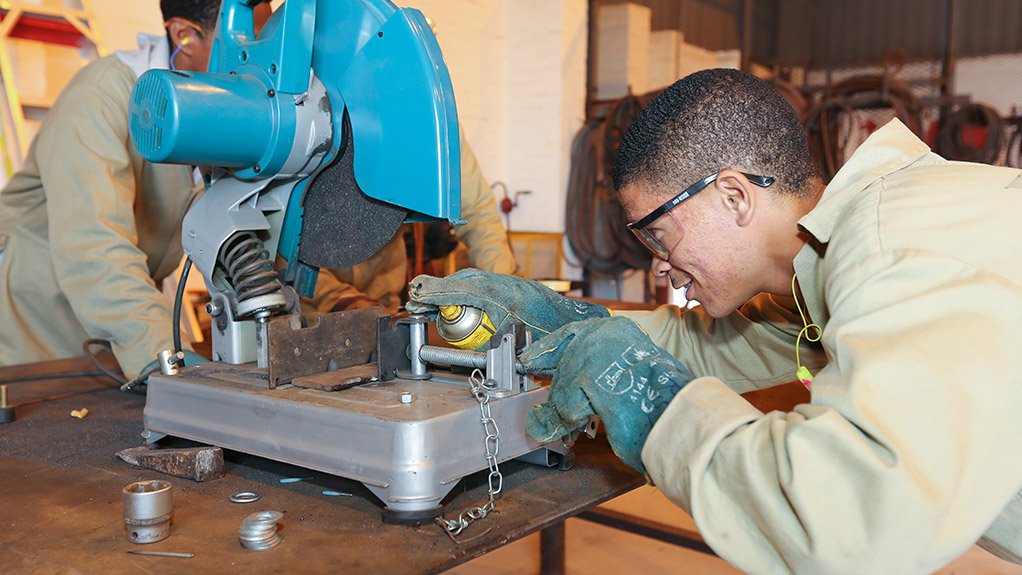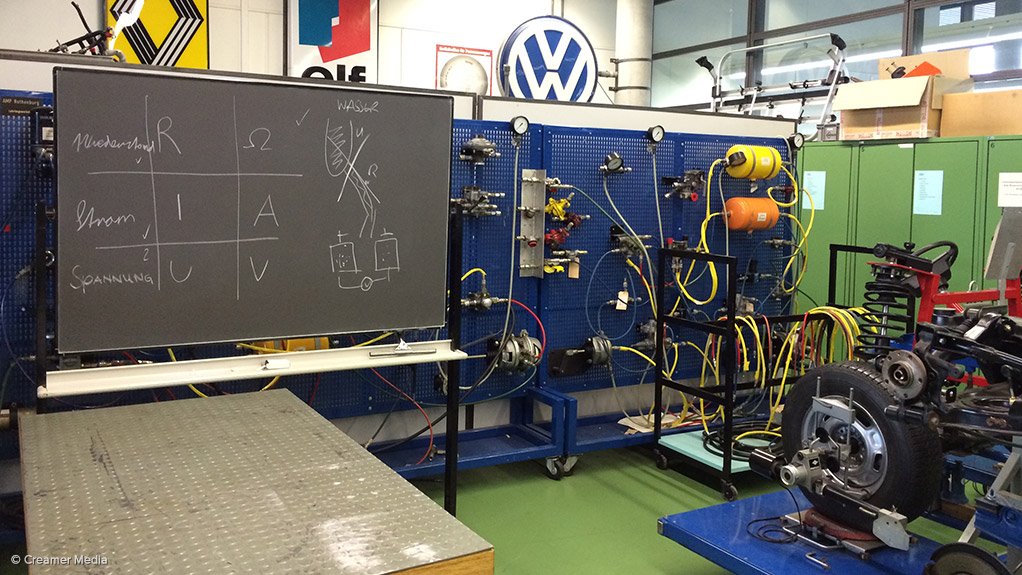South African firms yet to fully embrace dual-system apprenticeship model




FIRST DSAP INTAKE Inspired by the Swiss and German training model, the students spend two weeks a month at the Western Cape and Eastern Cape TVETs and two weeks at one of five participating companies to gain practical experience
SWISS VOCATIONAL SCHOOL An average-sized Swiss company has to invest about €25 000 a year to take on an apprentice, however, research shows that companies receive a rate of return on this investment of about 7% to 10%
Photo by Leandi Kolver
While results from the first year of the dual-system apprenticeship project (DSAP) pilot in South Africa have been positive, with a second intake of learners and additional pilot sites being planned, convincing employers to participate remains a challenge, representatives from the Department of Higher Education and Training (DHET) and the Swiss South African Cooperation Initiative (SSACI) tell Engineering News.
The DSAP pilot, which aims to determine the potential value of applying the Swiss and German dual system of apprenticeship training to South Africa’s skills development challenges, officially started in April 2013, with the first intake of 40 learners at the Technical Vocational Education and Training (TVET) West Coast College, in the Western Cape, and Port Elizabeth College, in the Eastern Cape.
Inspired by the Swiss and German training model, the students forming part of the first DSAP intake, which covers the welding and mechatronics industries, spend two weeks a month at the Western Cape and Eastern Cape TVETs and two weeks at one of five participating companies to gain practical experience.
The DSAP pilot is managed by the SSACI, with the Manufacturing, Engineering and Related Services Sector Education and Training Authority (MerSETA) funding the training costs and the DHET providing additional funding for project management. The department also provides overall strategic direction through a steering committee comprising key stakeholders.
The SSACI and the DHET note that, generally, both pilot TVET colleges are doing well, adding that the five participating companies have indicated that they would like to take on a second group of learners at both colleges.
In addition to taking in additional learners at West Coast College and Port Elizabeth College, the SSACI and the DHET are also planning to establish an additional three project sites.
“The challenge, however, is finding employers who are willing to participate in the project. Even though employers are paid a training grant of R319 500 per apprentice to cover their training costs, it has been difficult to convince them to participate in the project,” says SSACI project manager Darryn von Maltitz.
Reasons for Reluctance
Steel and Engineering Industries Federation of Southern Africa (Seifsa) human capital and skills development executive Mustak Ally tells Engineering News that companies’ reluctance to participate in the DSAP can be attributed to various reasons.
He states that participating in the project holds safety risks for a company and it will also increase its employee numbers, which could affect a company’s labour agreement.
South Africa’s labour dispensation has to be taken into account because unions generally want their members to be trained before new people are employed, Ally says.
Participating in the dual system would also entail that someone within a company or organisation must consistently liaise with the TVET college, he adds, noting that “capacity and resources then also become an issue”.
Ally states that, despite some companies expressing interest in the DSAP, the TVETs were not necessarily located within reasonable proximity to the industry hub that will use the skills produced by a particular college.
“The fact that the learners are going in and out of the workplace for experience means that it is not practical to have a college in the Eastern Cape that offers training in trades that are mostly required by companies in Gauteng,” he explains.
Meanwhile, SSACI CEO Ken Duncan says the main reason for the reluctance of companies to participate is their perspective: “South African industry urgently needs to make the mindset shift that has taken place in many other countries . . . to regard skills training as an investment from which they can profit, rather than as a cost that must be minimised.”
He tells Engineering News that “apprenticeships could, and should, pay for themselves, without any government grants, but few employers are willing and able to take up the challenge of organising their training and work processes in a way that would make apprenticeships profitable”.
However, Ally states that, in the current economic climate, companies will aim to obtain grants; should grants not be available, companies might focus only on their immediate operational needs.
Although he “most definitely” believes that grants are assisting organisations in terms of training and development, Ally does not think that “as a country . . . we have matured . . . to the extent where we realise that it makes economic sense to have higher-end skills, which then enable us to become more innovative and do things differently”.
Swiss Example
The value of training for economic benefit, as opposed to using grants, is demonstrated by the Swiss example, where employers are not paid to train apprentices; however, 40% of companies still choose to do so, with apprenticeships currently offered in about 230 occupations.
Swiss State Secretariat for Education, Research and Innovation international cooperation in education project manager Jérôme Hügli told a South African delegation of government, business and training institution representatives during a visit to Switzerland in December last year that Swiss companies chose to train workers to ensure the necessary skills in the labour market in five years’ time.
Also addressing the South African delegation was Swiss Coordination Centre for Research and Education director Professor Stefan Wolter, who stated that Swiss companies further bene- fited from offering apprenticeships because these learners could be used to substitute unskilled workers within the company, which led to short-term benefits.
Further, keeping apprentices as permanent employees also enables a company to avoid the four- to five-month adjustment period that a new employee needs to familiarise himself or herself with the environment and systems of a company.
Further, Wolter noted that, for each apprentice, an average-size Swiss company had to invest about €25 000 a year; however, research showed that companies had received a rate of return on this investment of 7% to 10%.
However, he said it would not make economic sense for all companies to take in apprentices and, therefore, these companies should not be expected to do so.
Some companies were simply too small to generate enough work to justify an apprentice, while others did not have enough skilled work for the apprentice or only required highly skilled people, Wolter explained.
However, Swiss mechanical and electrical engineering industry and associated technology- orientated sector organisation Swissmem execu- tive board member for training and innovation Robert Rudolph told the delegation that Swissmem had found that small companies were largely benefiting from their participation in the apprenticeship system.
He explained that, at these smaller companies, apprentices were usually doing productive work much sooner than their counterparts in larger corporations, further influencing small companies’ productivity and labour costs positively.
Wolter did not believe that it made sense for any government to subsidise companies that provided training, as the costs would be significant. He added that the companies that chose to participate probably did so without the subsidy.
He quipped that a country would have to be quite rich to be able to subsidise a system that was not producing the desired effect.
Local Benefits
The SSACI and the DHET note that, in addition to the potential benefits mentioned by Hügli, Wolter and Rudolph, South African companies, in particular, could benefit from this system, as having apprentices in college for only two days a week and at the company for three days has proved less disruptive than the three-month block release system that is currently the general practice.
Further, the dual system also ensures that there are fewer gaps between a college and a participating company in terms of technology, work practices and ethos.
Duncan adds that, in the longer term, participating in this project will also provide an employer with an opportunity to shape what is taught by TVET colleges and how this is done, thereby enabling employers to reduce future training costs.
He says the SSACI has found that networking with existing contacts works best when recruiting companies to participate in projects such as the DSAP.
“In the SSACI’s experience of this project and of other initiatives we have been involved in over the past 13 years, we have consistently found that employers respond best to approaches from people they know . . . and to the example that employers set.
“What we need now are some good success stories, followed by more advocacy, espe cially from participating employers,” Duncan states.
Meanwhile, Ally says the dual system will start reaping success in South Africa once the partnership between companies and the TVETs is bedded down, the curriculum is in place, the mentors are in place and the labour issues are sorted out.
“[The dual-system] is something we should definitely persevere in, see where we can achieve small successes and then increase these successes,” he concludes.
Article Enquiry
Email Article
Save Article
Feedback
To advertise email advertising@creamermedia.co.za or click here
Comments
Press Office
Announcements
What's On
Subscribe to improve your user experience...
Option 1 (equivalent of R125 a month):
Receive a weekly copy of Creamer Media's Engineering News & Mining Weekly magazine
(print copy for those in South Africa and e-magazine for those outside of South Africa)
Receive daily email newsletters
Access to full search results
Access archive of magazine back copies
Access to Projects in Progress
Access to ONE Research Report of your choice in PDF format
Option 2 (equivalent of R375 a month):
All benefits from Option 1
PLUS
Access to Creamer Media's Research Channel Africa for ALL Research Reports, in PDF format, on various industrial and mining sectors
including Electricity; Water; Energy Transition; Hydrogen; Roads, Rail and Ports; Coal; Gold; Platinum; Battery Metals; etc.
Already a subscriber?
Forgotten your password?
Receive weekly copy of Creamer Media's Engineering News & Mining Weekly magazine (print copy for those in South Africa and e-magazine for those outside of South Africa)
➕
Recieve daily email newsletters
➕
Access to full search results
➕
Access archive of magazine back copies
➕
Access to Projects in Progress
➕
Access to ONE Research Report of your choice in PDF format
RESEARCH CHANNEL AFRICA
R4500 (equivalent of R375 a month)
SUBSCRIBEAll benefits from Option 1
➕
Access to Creamer Media's Research Channel Africa for ALL Research Reports on various industrial and mining sectors, in PDF format, including on:
Electricity
➕
Water
➕
Energy Transition
➕
Hydrogen
➕
Roads, Rail and Ports
➕
Coal
➕
Gold
➕
Platinum
➕
Battery Metals
➕
etc.
Receive all benefits from Option 1 or Option 2 delivered to numerous people at your company
➕
Multiple User names and Passwords for simultaneous log-ins
➕
Intranet integration access to all in your organisation



















